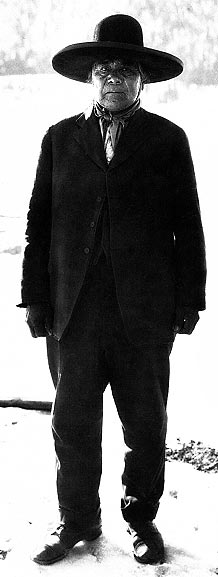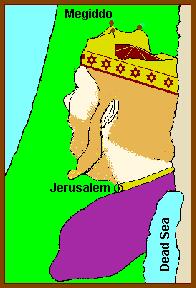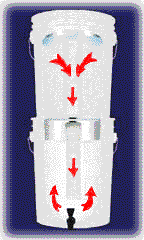
Parehaka Pa (Binney - Ancestral Voices)
Maori Prophets
"The missionaries despaired over many of the Maori's responses to the Christian
teachings.
But it was the scriptures which provided the model for a new dimension to
Maori spirituality." (Elsmore - Mana from Heaven)
"All the prophets tried to establish a common identity for the Maori as
Israelites, cutting across the tribal divisions while still accepting them
historically. They drew on traditional Maori concepts of the cosmology, and
particularly on the intervening role of the aria, the spirits of the ancestors,
who may appear to the living in many forms. The ancestors were and are believed
to speak with the mouth of the gods, and to be able to remember what has
not yet happened. These Maori concepts of cyclic history were brought into
the framework of the Judaeo-Christian faiths, and created the new religions.
The prophets believed, like the Israelites, that God moved with people through
time." (Binney - Ancestral Voices)

Te Kooti unverified (Elsmore)
Major Reference Works:
Short Vignettes:
Te Whiti
and Parihaka
The Taranaki is one of the worst examples of Pakeha appropriation of Maori
land. In southern Taranaki a new Maori prophet, Te Whiti, held up settlement.
He foretold that the day would come when the Pakeha would all go and leave
New Zealand for the Maori. Te Whiti opposed drinking alcohol and the prayer
meetings he conducted in his village at Parihaka attracted many followers.
Te Whiti believed that his tribe had been promised reserves when the government
had taken their land. These had not been given. To the Maoris, of course,
it was their land, not government land.
Te Whiti's followers began to resist the European occupation of the confiscated
land. They pulled out survey pegs and ploughed up nearby European farms in
a peaceful protest. What scared the government was that a leader of the ploughing
parties was the famous guerilla fighter Titokowaru. In 1881 the Native Minister,
John Bryce, led an expedition of the militia to occupy Parihaka, where they
were met by a couple of hundred children, singing and dancing. One of our
early poets, Jessie Mackay, wrote a parody of "The Charge of the Light Brigade"
to celebrate the victory of the militia. Te Whiti and another leader, Tohu,
were arrested and locked up for a year.
When they went back Te Whiti built a model village with piped water and
electricity. This was a new effort to lead his people to a successful life
in the world of the Pakeha.
 Rua
(Scott)
Rua
(Scott)
Rua's
New Jerusalem
As Te Kooti lay dying he said, "in twice seven years a man shall arise in
the mountains to succeed me. He shall be the new prophet of the people."
Rua Kenana said that he was that man. He called himself Te Mihaia Hou, the
new Messiah. As Te Kooti had done, Rua used the sufferings of the Jews to
explain the present suffering of the Tuhoe people. His followers called
themselves Nga Iharaira (the Israelites), and his settlement at Maungapohatu,
in the Ureweras, was called New Jerusalem. Rua promised the Tuhoe that their
lands would be returned and that Pakeha rule would come to an end. At its
peak, Rua's New Jerusalem attracted over a thousand people, mostly from the
Tuhoe and Whakatohea tribes. Maungapohatu was very isolated and few Pakehas
had ever been there. Strange stories were told by people who knew nothing
about Rua and who were afraid of Maori prophets. During the First World War
Pakeha fears began to centre upon Rua's attitude to the war. He told his
followers that the time for fighting was past. They should not fight in the
Pakehas' war. It was a short step from that to the Pakehas believing that
Rua was on Germany's side. People began to call Rua "the Maori Kaiser" and
to talk about the New Jerusalem as Rua's "stronghold". The government decided
to arrest him.

Children playing on the mud slide outside the school at
Maungapohatu (Basset et. al.)
In March 1916 the invasion of Maungapohatu was planned. Seventy police were
sent in three groups. There were a large number of mounted police, some of
whom had been at Waihi in 1912. Because Rua's village was so remote, the
police had to take a lot of gear and camp on the way. They moved like a small
army with waggons and pack- horses. They were convinced that when they reached
Maungapohatu there would be a fight. In fact there was no resistance. Rua
came to meet them with his two eldest sons, Whatu and Toko. But when the
police moved suddenly to seize Rua there was a scuffle and a gun went off.
No one knows whose. Immediately there was panic. The police had been expecting
an ambush and thought this was it. Toko Rua ran for his gun and wounded four
policemen before he was shot and killed. Toko's best friend, Te Maipi, was
also killed. Rua, Whatu, and four others were arrested. Rua was charged with
sedition (a kind of treason). His trial in the Auckland High Court lasted
forty-seven days. It was the longest trial in New Zealand history until 1977.
None of the charges against Rua based on the events of 2 April could be made
to stick, but he was found guilty of a lesser offence - being unwilling to
be arrested at Te Waiiti on 12 February. The judge sentenced him to twelve
months' hard labour and eighteen months' imprisonment, a very heavy sentence.
Eight members of the jury signed a petition protesting at the harsh treatment
of Rua.

Maungapohatu today (O'Connor and Melbourne)
The cost of defending themselves at the trials that followed the raid on
Maungapohatu, and the cost of the raid itself, which the Maoris had to pay,
almost ruined Rua's people. They had to sell much of their land and all their
animals. Pleas for help were met with indifference. "No anxiety need be felt
as to Rua's wives or children starving. Natives always help one another and
if ever they become short of food they will either go back to their own people,
or get married to other Natives," reported an official sent to look into
their desperate plight. When Rua returned to his followers in 1918 he found
them much poorer. Many people had left the settlement, but others stayed
with him until his death on 20 February 1937. Some still believe that he
will return to them, as he promised.
 Ratana (Basset et. al.)
Ratana (Basset et. al.)
Tahupotiki
Ratana and the
Ratana religion
Tahupotiki Wiremu Ratana was the founder of a Maori religious movement which,
in the late 1920s, also became a major political movement. His prophetic
descent included Te Ua Haumene, Tawhiao Te Wherowhero, Tohu Kakahi, Te
Whiti-o-Rongomai, Titokowaru, Te Kooti Arikirangi, Paora Te Potangaroa and
Mere Rikiriki. Through his grandfather, Ratana Ngahina, he was connected
to Ngati Apa, Nga Wairiki, Nga Rauru and Ngati Hine. Ratana Ngahina was respected
as a chief and generous benefactor of the community. Ratanas mother was
Methodist; his senior kinswoman, Mere Rikiriki, a faith healer and dispenser
of herbal medicine, had been at Parihaka with Te Whiti and Tohu and had later
established her own Church of the Holy Spirit at Parewanui. She taught Ratana
her beliefs and skills. He was exposed to strong but diverse religious and
political influences.
Although Mere Rikiriki had prophesied in 1912 that Ratana would become a
spiritual leader, he showed little sign of his potential until 1918. That
year, events occurred which were later interpreted as omens of significance.
On 8 November, he saw a strange cloud like a whirlwind approach. As he ran
towards his house he experienced a vision of all the worlds roads stretching
towards him and felt a heavy but invisible weight descend upon his shoulders.
His family saw that he looked strange. He had been struck dumb, but the Holy
Spirit spoke through him to his family: May peace be upon you; I am the Holy
Spirit who is speaking to you; wash yourselves clean, make yourselves ready.
Ratana was regarded as the Mangai (mouthpiece) of the Holy Spirit, and in
later years this day was celebrated as the anniversary of his maramatanga
(revelation).
Through the next few weeks Ratanas family believed him mad. At times he spoke
with the voices of the Holy Spirit or the archangels Gabriel or Michael.
He cleared out his house and took his family for night walks over rugged
farm land. He put all the clothes and belongings of some members of his family
in piles and said they belonged to the dead; all of their owners died in
the influenza epidemic then raging throughout New Zealand. Those who had
followed his advice to leave their homes survived. As his strange behaviour
continued, Te Urumanaao and other family members came to believe that he
was not mad but divinely inspired.
Ratana began to show an ability to heal through prayer. The first healing
was that of his son Omeka, who had become ill in October when a needle became
lodged behind his knee. A planned operation at Wanganui Hospital did not
eventuate because the needle could not be located. Omeka was brought home;
it was predicted that he would die. After a week of intensive prayer the
needle emerged from Omekas thigh. Word spread, and at a hui tangihanga for
all those who had lost family members in the influenza epidemic, the Whanganui
chief Te Kahupukoro brought his bedridden daughter to see Ratana. After asking
the girl whether she believed in the power of the Father, Son and Holy Spirit,
Ratana told her to rise; she recovered to lead a normal life. This was the
second of many healings, and by the end of 1918 a growing number of visitors
came to Ratanas farm. The three years following saw the rapid rise of Ratanas
reputation throughout New Zealand and, after his first cures of Europeans,
further afield. He had 20 to 100 visitors daily; articles called him the
Maori Miracle Man.
Ratana also led a sweeping religious revival, mainly among Maori. In 1921
and 1922 he travelled throughout the North and South Islands with dozens
of supporters; marquees were erected to shelter them and some meetings were
attended by thousands. His motorcade between Napier and Tauranga was estimated
to have cost 1,300. All of these visits produced numerous conversions to
his teachings; in some places more than half the Maori population agreed
to become part of the morehu (survivors), the name for Ratanas followers.
In places visited by Ratana the cures witnessed lent weight to his prophetic
sayings, which were treasured afterwards. As part of his campaign against
traditional Maori religion and tohunga he deliberately desecrated places
of ancient tapu.
Ratana was physically unremarkable save for his piercing eyes. His voice
and manner were quiet and gentle; he adopted no histrionics and did not touch
his patients. His method was to question them about their illness and their
faith in the healing powers of the Father, Son, Holy Spirit, and the Faithful
Angels. If the answers were satisfactory he would command them to rise, or
set aside their crutches. He worked mainly with the lame, the blind or the
paralysed. He did not always aim for instant healing. A growing pile of crutches,
walking-sticks and wheelchairs at Ratana pa testified to his success.
From the beginning of his public mission, Ratana was criticised. Eyewitnesses
who attended his meetings said they had seen no cures, and the reports of
miracles were often second-hand. Even the famous cure by letter of Fanny
Lammas was said to be through auto-suggestion. Accusations were made that
sick followers were refusing to visit doctors. Orthodox Christians claimed
Ratana was worshipping angels.
The King movement leader, Tupu Taingakawa, was among those who challenged
him in 1920 to care for the sicknesses of the land as well as those of the
body. Ratanas response was that first it was necessary to unite the people
in the worship of Jehovah.
On 18 March 1924 Ratana and his family visited Mt Taranaki and Parihaka.
Beside a stream on the mountain he heard a voice repeating words of Titokowaru,
and encountered at Parihaka sayings left by Te Whiti and Tohu that foretold
that he must take his spiritual message to the wider world.
 Ratana Church at Mangamuka
Left and right towers are Arepa and Omeka (Morrison 22). Note the crescent
moon and star on each tower. Ratana believed the Maori and the Japanese were
lost tribes of Israel. (see below) Mormons likewise
believe the Amerindians are a lost tribe. Ratana visited the Japanese their
peoples were formally married there. Much later during World War II, Jews
were welcomed into Japan where the Makuyo sect still claims a relationship
with Judaism. A 'Davidic star' appears on the Ise shrine. (Jones 143).
Ratana Church at Mangamuka
Left and right towers are Arepa and Omeka (Morrison 22). Note the crescent
moon and star on each tower. Ratana believed the Maori and the Japanese were
lost tribes of Israel. (see below) Mormons likewise
believe the Amerindians are a lost tribe. Ratana visited the Japanese their
peoples were formally married there. Much later during World War II, Jews
were welcomed into Japan where the Makuyo sect still claims a relationship
with Judaism. A 'Davidic star' appears on the Ise shrine. (Jones 143).
A breach with orthodox religions developed over the years, provoking intense
theological debates at Ratana pa. Initially, Ratana had discouraged attempts
to deify him, but within two years the Ratana formula for the godhead included
the Mangai, as well as Father, Son and Holy Spirit. Ratana began to refer
to other churches as introduced to New Zealand by gentiles, and therefore
not fit for his people. In the early 1920s the Mangai had often prayed publicly
in the name of Jesus; in the 1930s this practice was dropped and the Mangai
himself was sometimes regarded as the kaiwhakaora (saviour). Both his sons
Arepa (Alpha) and Omeka (Omega), always regarded as imbued with spiritual
forces, died early in the 1930s, and not long afterwards the Mangai began
to encourage his followers to regard them as Ratana saints or mediators.The
final straw for the orthodox was that Ratana abandoned monogamy. In 1925,
encouraged by Te Urumanaao, he took a second, much younger, wife to protect
him against the infatuation of thousands of admiring women; this was Iriaka
Te Rio, one of the dance troupe of girls who had travelled with Ratana. He
had two children by her. Te Urumanaao was known from this time by the title,
Te Whaea o te Katoa (the mother of all).
"On his first overseas trip Ratana had returned
via Japan, visiting a Japanese Christian bishop. Relations with the Japanese
had been very good; it was the highlight of the trip. Ratana thought that
both Maori and Japanese were among the lost tribes of Israel. A marriage
between two of his party took place in Japan, the ceremony presided over
by a Japanese bishop" (Ballara).
"The idea grew that Ratana had married the Maori race to the Japanese race,
had enlisted their support for Maori grievances and had prophesied the coming
of worldwide war between the non-white and white races. He was accused of
brandishing a Japanese Dagger and flying the Japanese flag at Ratana pa.
Eyewitnesses denied these stories, and Ratana himself gave a speech describing
his familys loyalty to the Crown, but some Maori leaders grew concerned and
reported their fears to the government. When Pita Moko issued an official
denial and published the text of Ratanas new covenant to demonstrate that
the church was not disloyal, some morehu were disappointed at what they regarded
as a betrayal and withdrew from the movement. Ratanas healing power, as he
had predicted, was deserted him, although Pita Moko continued to report some
cures" (Ballara).
In 1928 he decided that four of his followers should stand for Parliament.
He could see that government money was spent to help Pakeha New Zealanders
and he wanted a strong voice for ordinary Maoris in Parliament. The first
Ratana Member of Parliament was Eruera Tirikatene, who won Southern Maori
in a by-election in 1932. When Labour won the 1935 election Ratana went to
see the Prime Minister, "Micky" Savage, at Parliament Buildings. He placed
on the table, a potato, a broken gold watch, a greenstone tiki, and a huia
feather. Savage looked at these things and asked Ratana to explain what they
meant. The potato was the ordinary Maori who needed his land because "a potato
cannot grow without soil". The watch was broken, like the law which protected
Maori land; the law of the new government must repair the broken law of the
old one. The tiki stood for the spirit of the Maori. If Savage protected
the Maori people he would earn the right to wear the huia feather, which
was the sign of a chief. Since Ratana's visit to Savage most Maoris have
supported the Labour Party, and all four seats have been Labour since 1943.
The votes of Maori members twice kept Labour Governments in power, 1946-49
and 1957-60. Ratana died on 18 September 1939. His message to his people
was that they could survive in a Pakeha world - even in the cities. The angels
would strengthen those who believed. The Ratana religion gave them confidence
and Ratana's practical advice helped them to manage in the modern world.
from: Bronwyn Elsmore Mana from Heaven 381
The mission of T.W. Ratana had two aspects - these having been pointed to
in the first sign of the beaching of the two whales. The first was the spiritual
aspect. This was symbolized in two ways - by the whale which lay still on
the sand and represented the soul, and by Arepa (Alpha) one of the twin sons
of the Mangai. In 1928, the running of the church was handed over to the
committee which had been set up. Ratana announced that from then on his spiritual
mission was completed and his material works were to begin. Arepa who was
a young man of eighteen recognized that his life was over, and after a long
illness died in the last minutes of the year 1930. The second aspect, the
material work, was symbolized by Omeka (Omega) the other twin son; and also
by the second whale which had thrashed around for some time before dying
and therefore represented the body and "the conflicts between the Movement
and the rest of society. Ratana saw this part of his function centred mainly
on the promotion of recognition of the promises included in the Treaty of
Waitangi. This included a long campaign to have Ratana candidates elected
to the four Maori seats in Parliament. The first was elected in a by-election
in 1932, a second in 1935, and by 1943 all four seats were held by Ratana
members, a state that continued for twenty years until 1963. When Eruera
Tirikatene succeeded to the House he took Omeka into the debating chamber
in order to show that the material aim was now accomplished. The second twin's
purpose was then completed - he went to bed and died that November.
The Mangai himself died on 18 September 1939 having passed on the responsibility
of continuing his spiritual and material works to his eldest son Tokouru
and others of his family.
-
Ballara, Angela, Ratana, Tahupotiki Wiremu, NZ Dept of Internal Affairs
-
Bassett Judith, Sinclair Keith, Stenson Marcia 1985
The Story of New Zealand, Whitcouls, NZ
-
Morrison, Robin 1994 A Journey, Tandem Press, Auckland. ISBN 0-908884-53-2
-
Scott, Dick 1962 Inheritors of a Dream, Donald Riddell, Auckland.
WEBMASTERS:
Click here to generate maximum cash for your web site!



























 Rua
(Scott)
Rua
(Scott)



 Ratana Church at Mangamuka
Left and right towers are Arepa and Omeka (Morrison 22). Note the crescent
moon and star on each tower. Ratana believed the Maori and the Japanese were
lost tribes of Israel.
Ratana Church at Mangamuka
Left and right towers are Arepa and Omeka (Morrison 22). Note the crescent
moon and star on each tower. Ratana believed the Maori and the Japanese were
lost tribes of Israel. 


